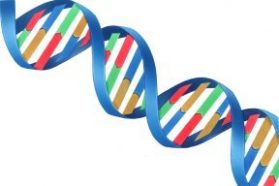Baby Swaps, Crime Scenes, and DNA Testing Additional Information
The Veterinary Genetics Laboratory at the University of California, Davis has a Web site at http://www.vgl.ucdavis.edu/.
DNA identity: http://www.sciencefriday.com/kids/sfkc20030411-1.html Science Friday Kids’ Connection
Basic information about DNA and genes: http://gslc.genetics.utah.edu/units/basics/
Eccles Institute of Human Genetics, University of Utah
Introduction to DNA: http://www.eurekascience.com/ICanDoThat/dna_intro.htm
Eureka ! Science, Corp.
![[book]](https://www.sciencenewsforstudents.org/wp-content/uploads/2019/11/a129_b1149.jpg) |
DNA Fingerprinting: The Ultimate Identity— Ron Fridell
Published by Franklin Watts/Scholastic, 2001.
Every cell in the human body contains something called DNA, the blueprint that contains all the information that makes your body different from everyone else’s. Unless you have an identical twin, no one on earth has the same DNA that you do. This comes in handy in solving crimes, because while smart criminals might be able to avoid leaving actual fingerprints, it is nearly impossible not to leave behind some DNA (it’s in your sweat, tears, dead skin cells, etc.). Learn how scientists and law enforcement work together to use this information to track down dangerous criminals. This book tells how and shares some interesting stories of real crimes that DNA evidence has helped solve. |
![[book]](https://www.sciencenewsforstudents.org/wp-content/uploads/2019/11/a129_b2176.jpg) |
DNA— Alvin Silverstein, Virginia Silverstein, Laura Silverstein Nunn
Published by Chelsea House, 2002.
Every living thing is made up of cells, yet plants and animals and humans are obviously very different. The secret to the differences—and the similarities—is in DNA. Explore the mysteries of DNA and find out how scientists are working to unravel them. Learn about amino acids, RNA, and the structure of DNA; discover how heredity works; and find out about mutations and genetic disorders. The Human Genome Project, DNA fingerprinting, and genetic engineering are also discussed. |
![[book]](https://www.sciencenewsforstudents.org/wp-content/uploads/2019/11/a129_b3436.jpg) |
Health Science Projects about Heredity— Robert Gardner
Published by Enslow Publishers, 2001.
The Science Projects books by Robert Gardner are packed with dozens of step-by-step experiments and activities you can perform yourself. Each one includes an introduction to a particular subject, safety hints, a list of scientific equipment suppliers, and an index. Gardner also marks the experiments he thinks would make good science fair projects. This book is about genetics, the science of heredity. Experiments include: “Making your Own Family Tree”; “Eye Color and Genes”; “A Three-Dimensional Model of DNA”; and “Cloning, Food, and Humans.” |
Power Words
DNA: Short for deoxyribonucleic acid. The material that makes up the genes and that is found in all cells. DNA controls the function of all the cells in the body. DNA in the body consists of two thread-like strands that are linked together in the shape of a double helix.
 |
| A strand of DNA is shaped like a twisted ladder. The rungs of the “ladder” are made of four different bases. |
| Carlyn Iverson/The American Heritage® Children’s Science Dictionary |
DNA fingerprinting: The use of DNA to determine the identity of a person within a certain probability. DNA fingerprinting is done by analyzing repeating patterns of base pairs in DNA sequences that are known to vary greatly among individuals.
gene: A tiny part of a chromosome, made up of molecules of DNA. Traits are passed from parent to offspring through the genes. The shape of a plant leaf, the color of an animal’s coat, and the texture of a person’s hair are all determined by genes.
Copyright © 2002, 2003 Houghton-Mifflin Company. All rights reserved. Used with permission.
